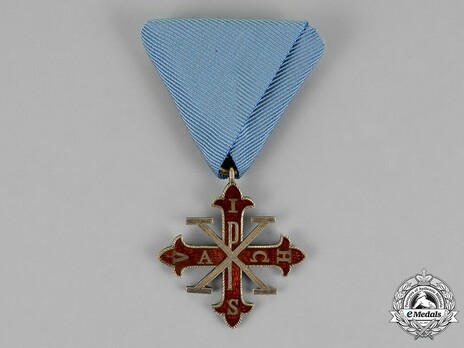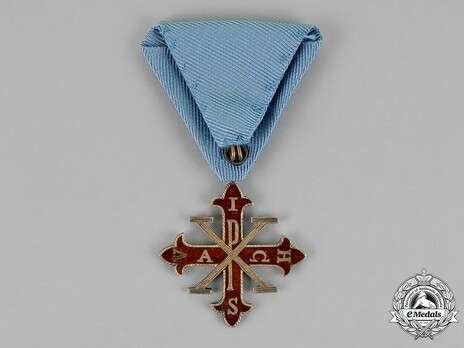Constantinian Order of St. George, Knight II Class (c. 1845, Office)
CATEGORY: Version
SKU: 01.ITA.0105.108.01.000
Estimated market value:


Estimated market value:
In silver with red enamels, measuring 38 mm (w) x 38 mm (h), on its original triangular ribbon with hook and eye, intact enamels, extremely fine.
The origins of the Order are unclear. Some authorities believe the beginning of this Order can be linked to Emperor Constantine I and the Battle of the Milvan Bridge in 312. Others believe the founder was Byzantine Emperor Isaac II in 1190.
The best-recognized iteration of the Order arose with the amendments to the Order statutes made by Duke Francesco Farnese of Parma in 1705. The Duke’s changes were formally recognized by Pope Clement XI in 1706 and finalized as a dynastic Order of the Duchy of Parma by a Papul Bull in 1718.
It became a dynastic Order of the Kingdom of the Two Sicilies in 1731, following the death of Antonio Farnese, the last male descendant in Parma of the Farnese dynasty. Consequently, the Order passed to the King of the Two Sicilies, Charles III, resulting in the move of the Order out of Parma and into Naples.
Thus from 1731-1816, it was not considered an Order of the Duchy of Parma. When Marie Louise ascended to the throne of the Duchy of Parma, Piacenza and Guastalla she restored it as a dynastic Order of the Duchy of Parma, resulting in the creation of two Order branches.
The Duchy of Parma Order branch features a lower case omega in the inscription “V I H S A ω P.”
The Kingdom of the Two Sicilies Order branch features an upper case omega in the inscription “V I H S A Ω P.”
Members of the Order were predominately noble, and they were charged with defending Roman Catholic beliefs and traditions.
The motto of the Order is “In hoc signo vinces,” which roughly translates to “In this sign you will conquer.”
There is a lot of variation in the size, composition, and design of the Order awards due to the long history of the Order.
The Order might be awarded within the following categories: Special Class, Justice, Jure Sanguinis, Merit, Office, and Medal. Each of these has their own grades.
See Constantinian Order of St. George in the Orders of the Kingdom of the Two Sicilies in Italy for more information.
Special grades consist of: Sovereign Knight Grand Cross with Collar, Knight Grand Cross, and Special Class.
Justice grades consist of: Bailiff Knight Grand Cross with Collar of Justice, Bailiff Knight Grand Cross of Justice, Knight/Dame Grand Cross of Justice, Knight/Dame Grand Officer of Justice, Knight/Dame Commander of Justice, and Knight/Dame of Justice.
Jure Sanguinis grades consist of: Knight/Dame Grand Cross of Grace, or Jure Sanguinis, and Knight/Dame of Grace or Jure Sanguinis.
Merit grades consist of: Knight/Dame Grand Cross of Merit, and Knight/Dame Grand Commander of Merit, and Knight/Dame of Merit.
Office grades consist of: Knight/Dame of Office.
Medal grades consist of: Gold, silver, and bronze.
In Mb, we have tried to identified each of the previous categories, however, more research is still needed.
The Knight II Class is not surmounted by a crown, and recipients were often known as Serving Brothers, Squires, or Shield Brothers.
The original form of the Knight II Class is a pinback, and the later form was instituted in 1845 with the reforms made by Marie Louise.
The knight of justice features the badge suspended from a royal crown and a military trophy on a sky-blue ribbon, those who were officers for the right of blood presented only the crown suspension.
The knight of office wore a plain badge suspended from a triangular chest ribbon.

Comments
Sign in to comment and reply.


Scroll Top